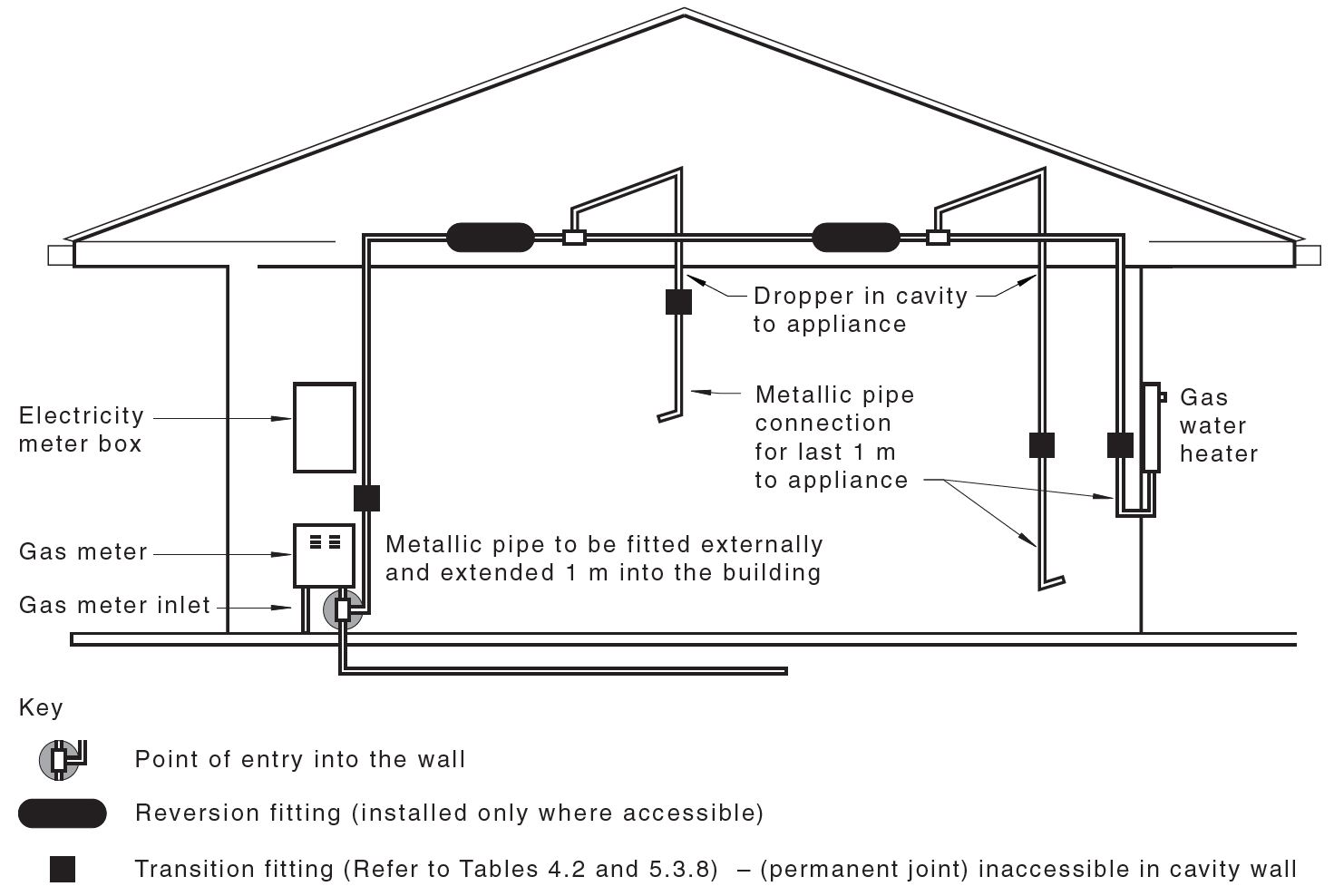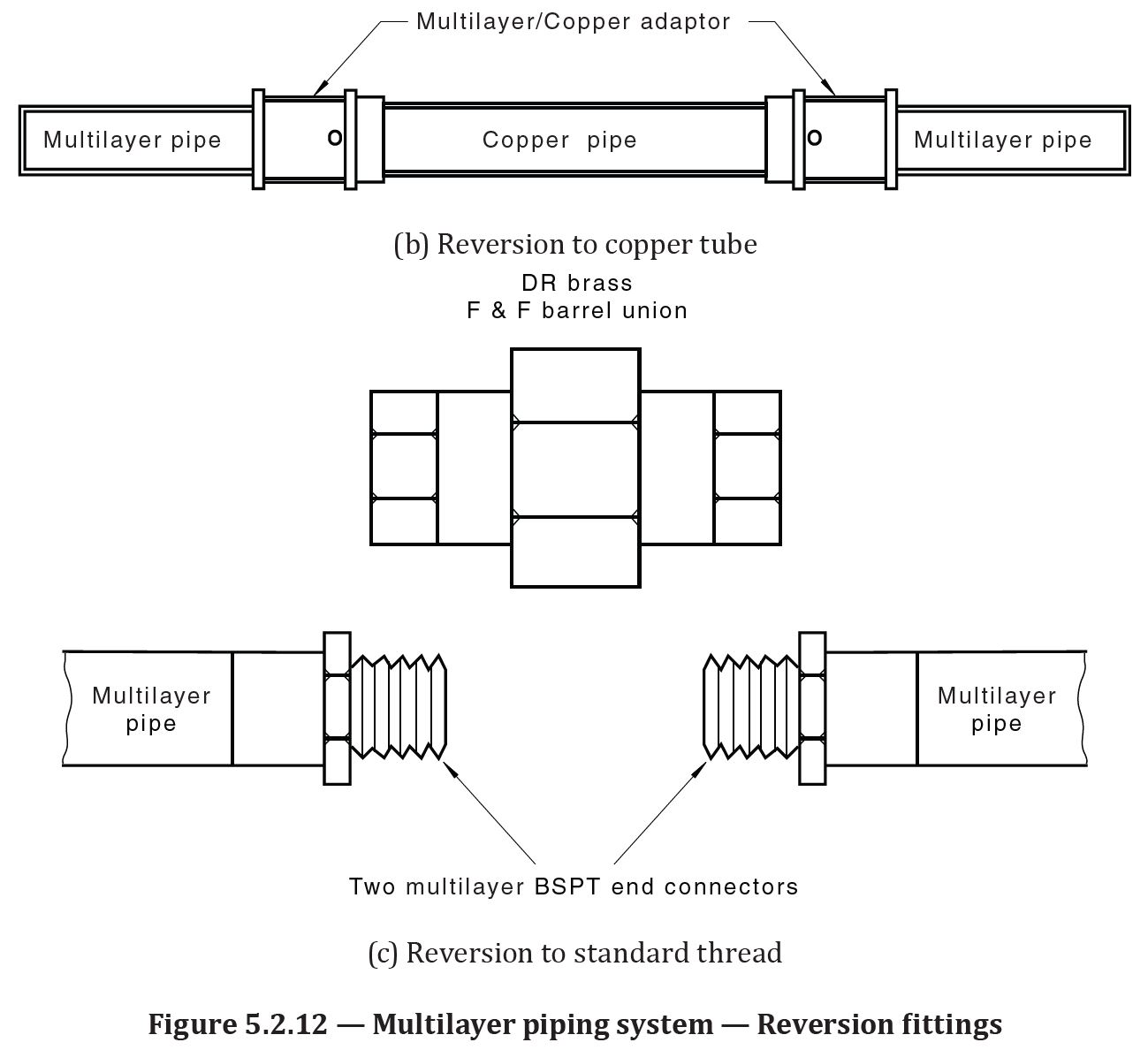| Advisory note | 10/2023 |
|---|---|
| For | Licensees and contractors working in the gasfitting and building industry |
| Scope | Applies to all areas in NSW |
Issue
A new revision of AS/NZS5601.1 has been released on 30 September 2022 (AS/NZS5601.1:2022) and becomes the referenced standard from 30 March 2023.
AS/NZS 5601.1 2013 has previously required the installation of reversion fittings in certain circumstances. AS/NZS5601.1:2022 still requires the installation of reversion fittings and provides some additional requirements regarding the installation of the consumer gas pipework.
All gas installations in NSW must comply with the Gas and Electricity (Consumer Safety) Act 2017 with any installation not conforming to AS/NZS 5601.1:2022 considered non-compliant.
Reference
Gas and Electricity (Consumer Safety) Regulation 2018
AS/NZS 5601.1:2022 - Gas Installations
5.2.12 Reversion fittings for proprietary multilayer piping
In installations in Class 1 buildings in Australia or detached or multi-unit dwellings in New Zealand, where a proprietary multilayer piping system having a main run exceeding 10m in length and connected to more than one appliance is being installed, reversion to standard thread conforming to AS ISO 7.1, BSPT, or a standard annealed copper tube, shall be provided at both of the following accessible locations:
(a) In the main run immediately prior to the first branch take off point.
(b) In the main run immediately prior to the last branch take off point.
Brazing, welding or annealing shall be conducted in accordance with the manufacturer’s specifications, but shall be not be less than 1m from a joint with non-metallic components.
Consumer piping external to the building shall be metallic and extend at least 1m into the building.
NOTE 1: An example is shown in Figure 5.2.12(a).
NOTE 2: Figure 5.2.12(b) and Figure 5.2.12(c) show acceptable reversion options for conformance to this Clause.
NOTE 3: The reversion fitting may be incorporated in the upstream side of the branch take off fitting.
NOTE 4: The intent is to allow for future extension or connection to a non-compatible piping system to protect the consumer/end user from difficulties that may arise from non-availability of the proprietary system.
NOTE 5: For definition of Class 1 building, see the National Construction Code (NCC).
Figure 5.2.12(a) - Example of reversion fittings in a multilayer piping system (composite pipe).
Figure 5.2.12(b) and (c) - Multilayer piping system - acceptible reversion fittings.
Relevant definitions - AS/NZS 5601.1 2022
1.3.1 - accessible
Where access can be gained without hazard or undue difficulty for inspection, repair, testing, renewal, or operational purposes.
1.3.86 - permanent joint
A joint that is not intended to, and cannot readily, be disassembled.
Examples of permanent joints are brazed, welded, crimped and hydraulically or mechanically compressed joints.
Relevant definitions - National Construction Code
Class 1 Buildings
Class 1 buildings are houses. Typically, they are standalone single dwellings of a domestic or residential nature.
A Class 1 building includes one or more of the following sub-classifications:
- Class 1a is one or more buildings, which together form a single dwelling including the following:
- (a) A detached house.
- (b) One of a group of two or more attached dwellings, each being a building, separated by a fire-resisting wall, including a row house, terrace house, town house or villa unit.
- Class 1b is one or more buildings which together constitute:
- (a) a boarding house, guest house, hostel or the like that—
- (i) would ordinarily accommodate not more than 12 people; and
- (ii) have a total area of all floors not more than 300m2 (measured over the enclosing walls of the building or buildings); or
- (b) four or more single dwellings located on one allotment and used for short-term holiday accommodation.
- (a) a boarding house, guest house, hostel or the like that—
Requirements
As required in Clause 5.2.12 (above), you must install a reversion fitting when:
- Installing a proprietary multilayer piping system in a Class 1 building and,
- Where the proprietary multilayer piping system has a main run exceeding 10m in length and,
- More than one appliance to be installed.
A reversion fitting shall be provided at both of the following accessible locations:
- In the main run immediately prior to the first branch take off point.
- In the main run immediately prior to the last branch take off point.
Fair Trading consider the following example diagrams below to meet the requirements of AS/NZS 5601.1 2022: Clause 5.2.12.
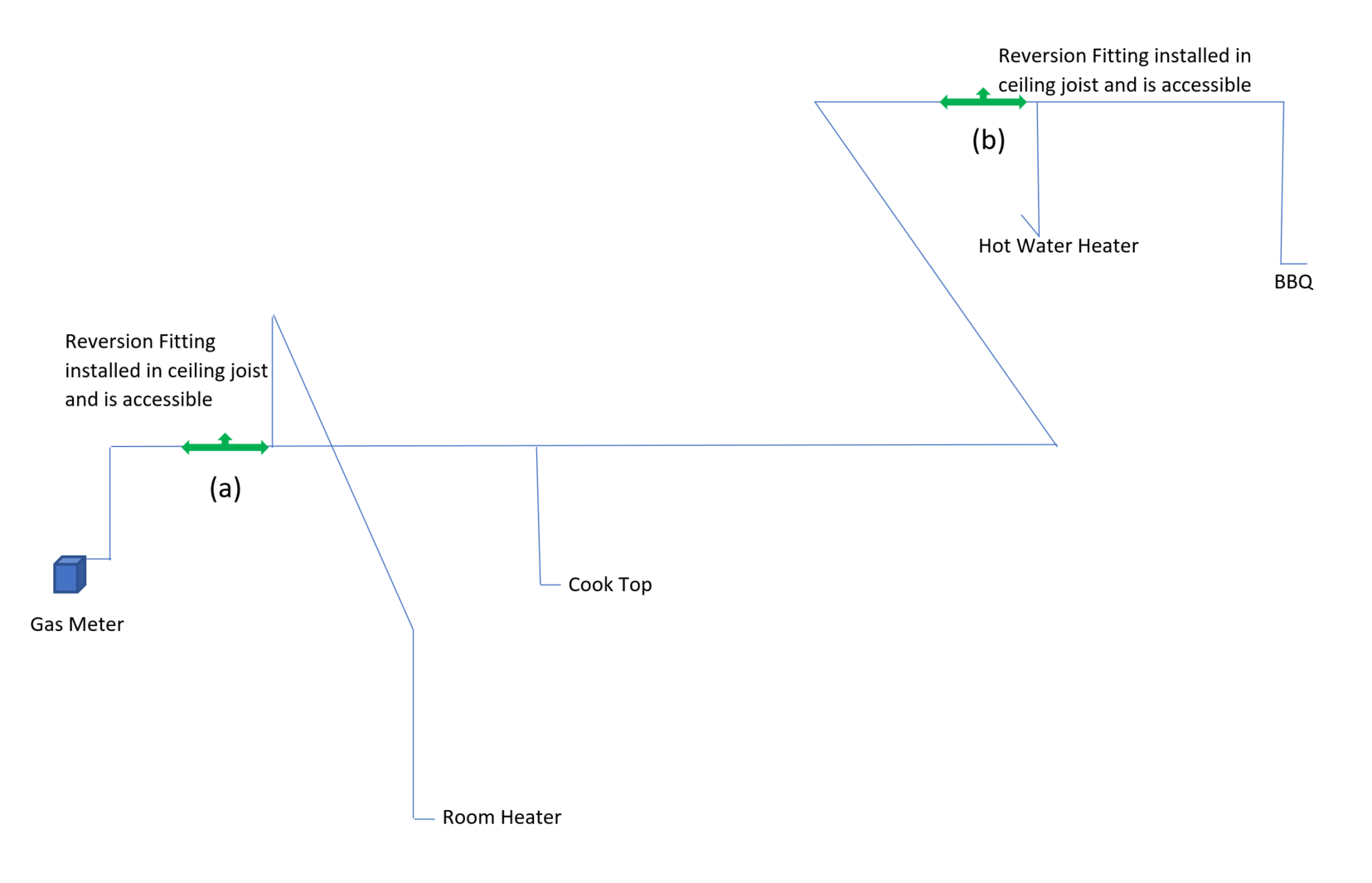
Example 1: The reversion fitting installed using permanent joints in a wall or ceiling, the same size as main line in an accessible location. If the reversion fitting is installed using a union, screwed fitting or similar non-permanent joint, the wall or ceiling also needs to be ventilated as per the ventilation requirements prescribed in AS/NZS 5601.1 2022.
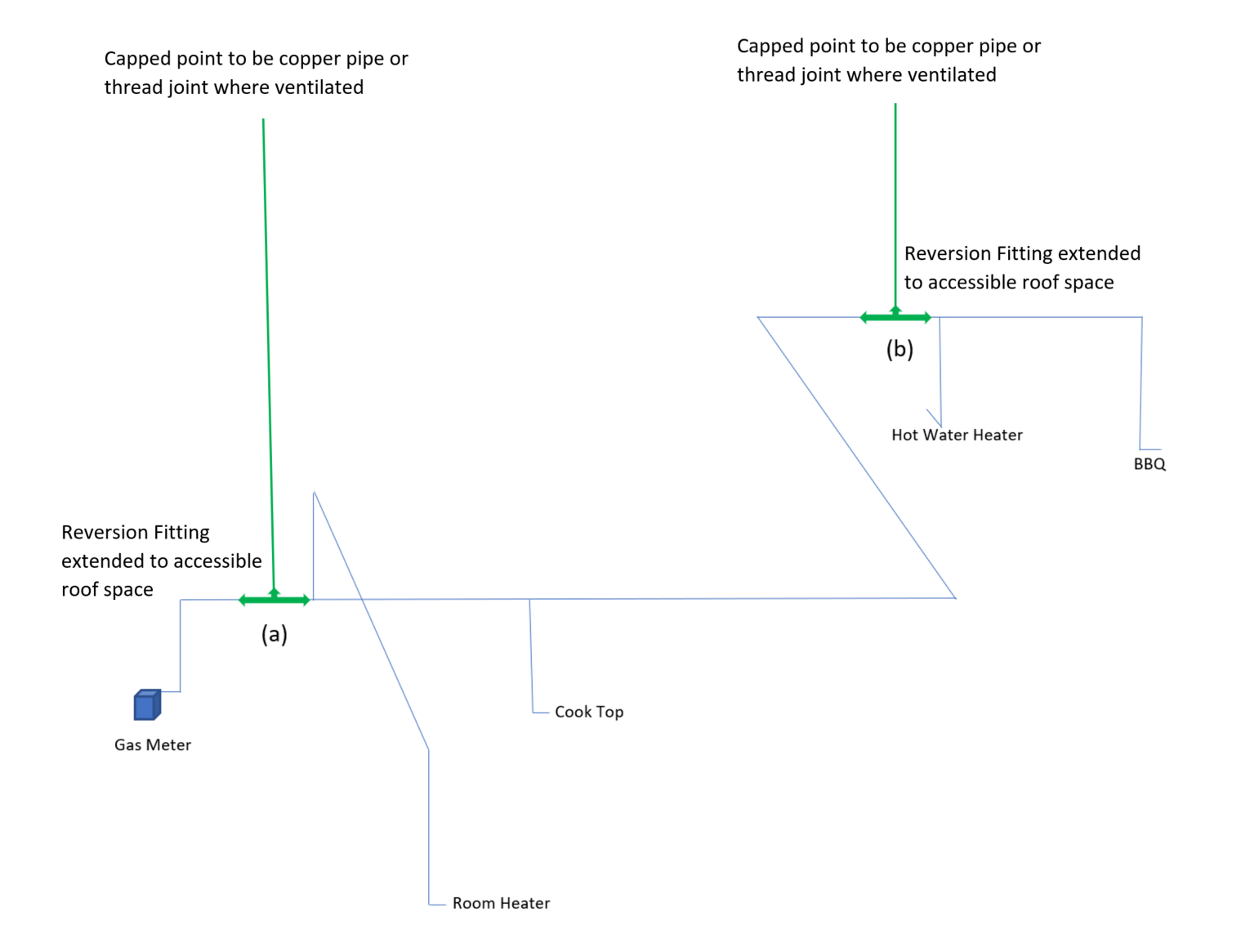
Example 2: Reversion fitting, the same size as the main line can be extended to the accessible roof space. If the reversion fitting is installed using a union, screwed fitting or similar non-permanent joint, the roof space will also need to be ventilated as per the ventilation requirements found in AS/NZS 5601.1 2022.
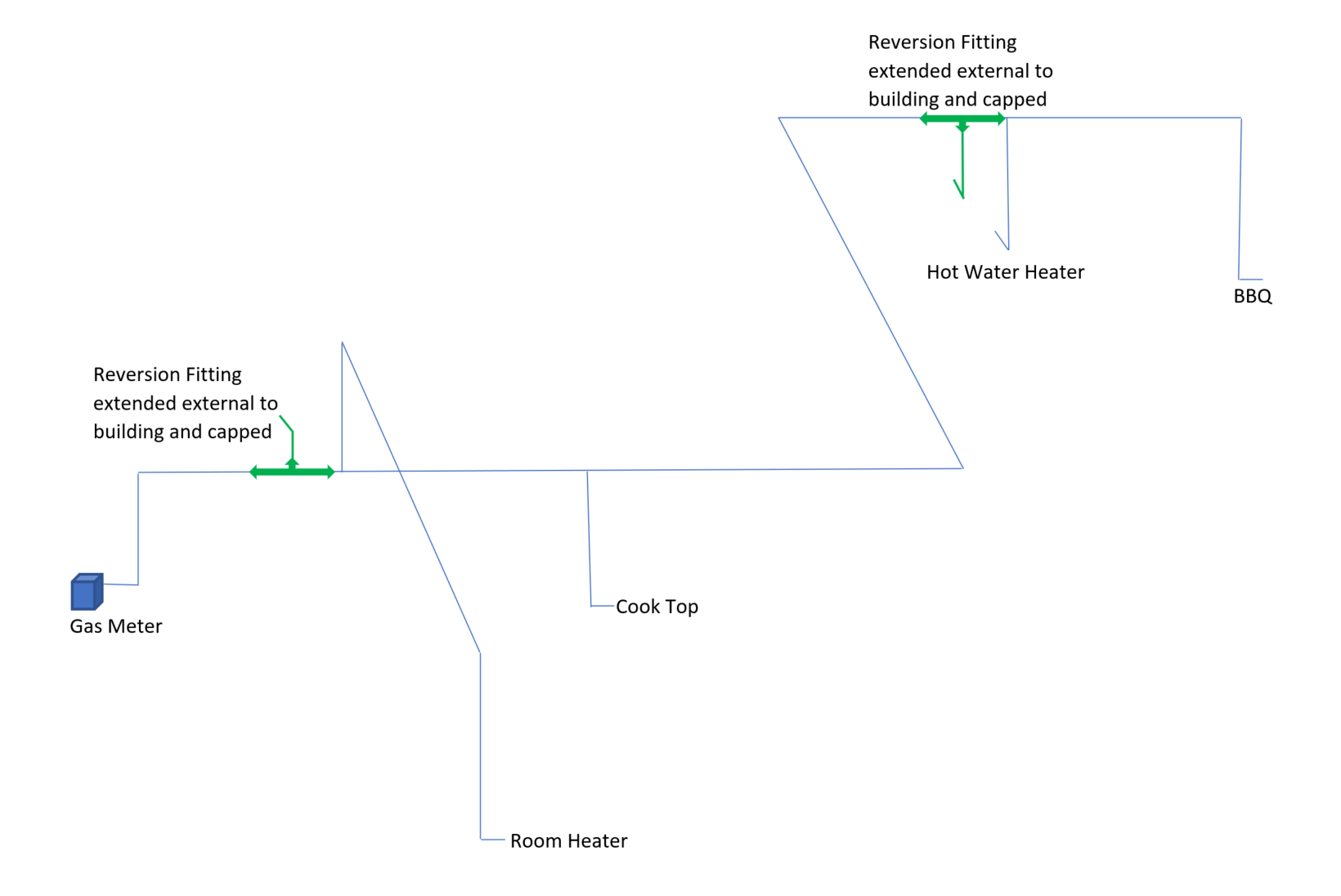
Example 3: Reversion fitting extended to external wall. The pipework extending the reversion fitting must remain the same size as the main line to the capped point installed in an accessible location. Capped point must have a sign stating, “Gas Reversion Fitting”.
In addition to the above reversion fitting requirements:
The gas consumer piping shall be installed in accordance with AS/NZS 5601.1 2022 – Table 4.2, referencing the applicable pipe material being installed.
The transition fittings referenced in Figure 5.2.12(a) shall be installed referring to Table 4.2 and Clause 5.3.8 (Piping in a concealed location other than underground or embedded in concrete) and be a permanent joint when installed inaccessible in a cavity wall.
Brazing, welding or annealing shall be conducted in accordance with the manufacturer’s specifications but shall be not less than 1m from a joint with non-metallic components.
Consumer piping external to the building shall be metallic and extend at least 1m into the building.
For more information, please email: [email protected]
This advisory note has been approved for issue by the BSCU Technical Review Committee. Information contained within this document is current as of January 2023 and refers to codes and standards current at the time of writing.
NSW Fair Trading disclaims any liability (including for negligence) to any person in respect of anything done, or not done, by that person in whole or partial reliance on any of the information in this advisory note.
